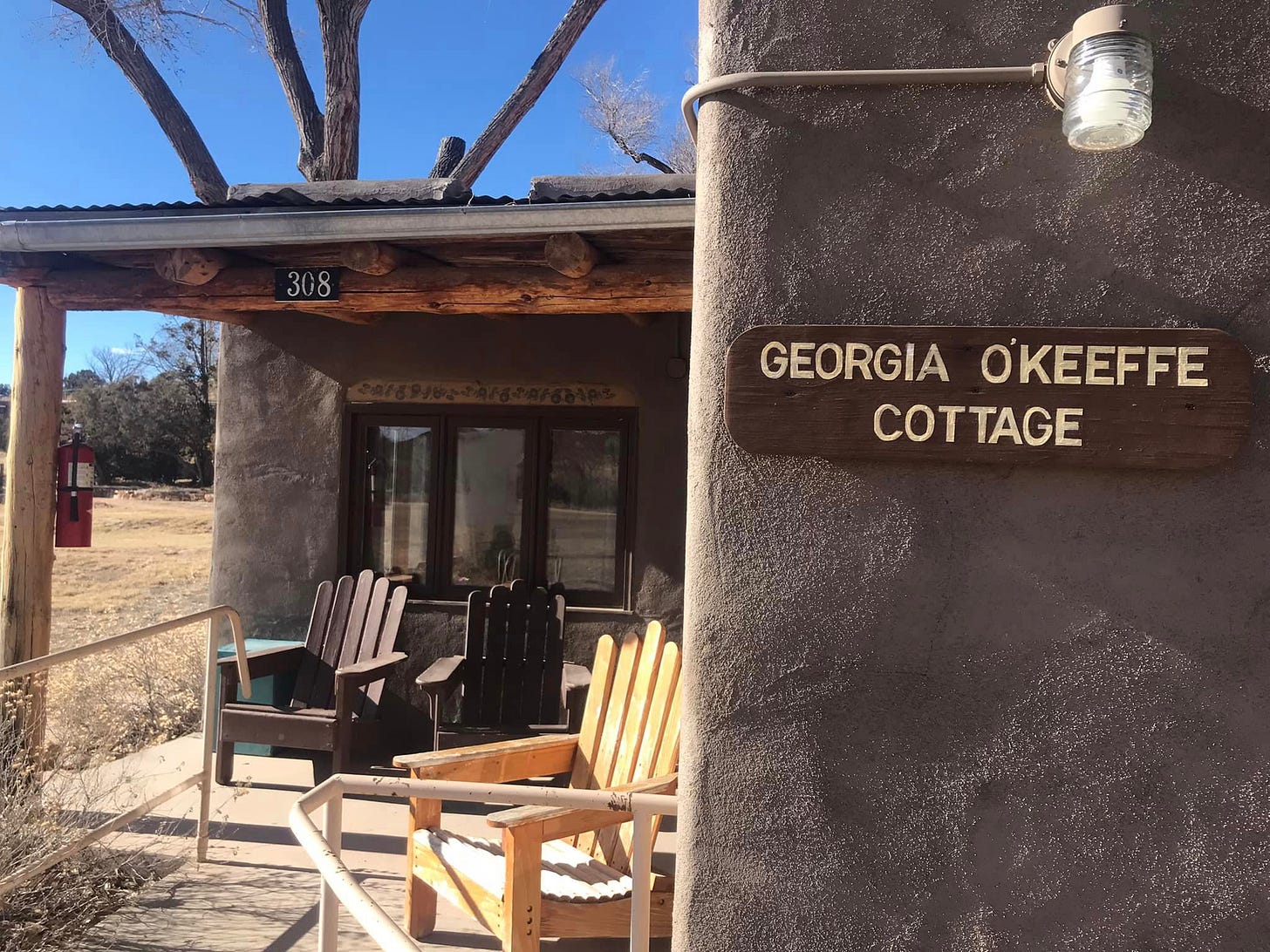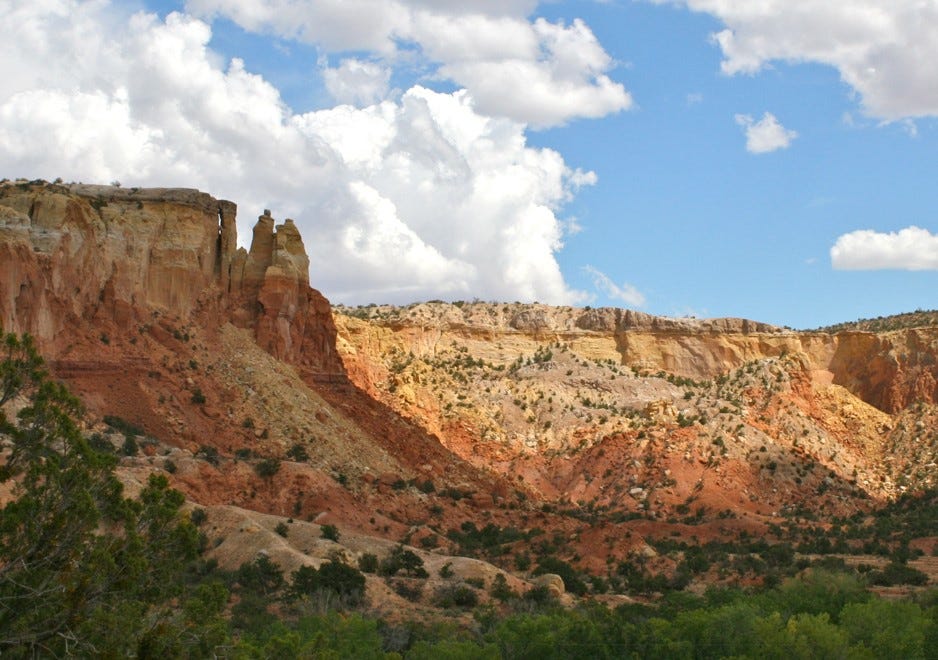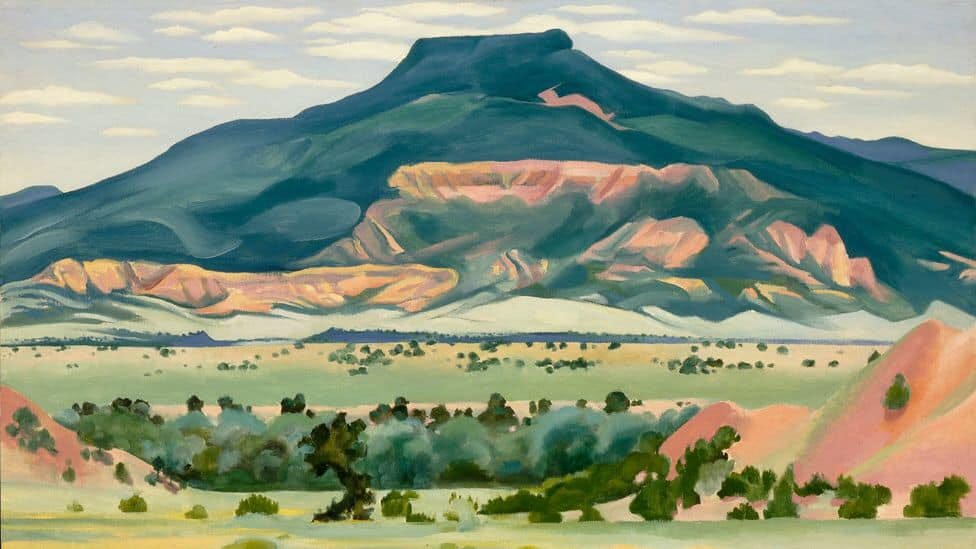Day Tripping in Santa Fe, Part 3
Ghost Ranch, Visions of Johanna, & More Apparitions by Mr. Dylan
When you're lost in the rain in Abiquiu, and it's Easter time too
And your gravity fails, and negativity don't pull you through
Don't put on any airs when you're on Ghost Ranch, New Mexiquiu
They got some hungry women there, and they'll really make a mess outta youIf you see Saint Georgia, please tell her thanks a lot
I cannot move my fingers, they are all in a knot
I don't have the strength to get up and take another shot
And my best friend, the doctor, won't even tell me what it is I've gotSweet Georgia, the peasants call her the goddess of gloom
She speaks good English, invites you up into her room
And you're so kind and careful not to go to her too soon
And she takes your voice and leaves you howling at the moon
You may recognize the slightly altered lyrics from the great wordsmith, poet, and Nobel Prize-winning bard, Bob Dylan - from one of his early classics, “Just Like Tom Thumb's Blues”, off his album, “Highway 61 Revisited”. Of course, he was down in Juarez, south of the U.S. border, at the time he wrote it, but by the power of poetry, cyberportation, and time travel, here he is, on Georgia O’Keeffe’s “Ghost Ranch”, in Abiquiu, New Mexico, haunting her little wooden, re-stuccoed, cottage in 2023.
Bob Dylan has a way of doing that - transcending time, history, and cultural boundaries - as perhaps Georgia O’Keeffe does herself. A match made in Heaven, or perhaps, even in, a place hotter and more provocative.
Let’s start with Robert Allen Zimmerman, born in Duluth, Minnesota in 1941, and raised in provincial Hibbing, Minnesota, on the red Mesabi iron-ore range, west of Lake Superior, by Abram Zimmerman & “Beatty” Stone, children of European Jews from Ukraine, Lithuania, and northeastern Turkey. Working in his father’s furniture and appliance store, young Bobby vacuumed up a headful of eclectic music over the pre-cable airwaves, particularly country and rhythm & blues over radio stations from Shreveport, Louisiana, up along Highway 61 and the Mississippi River. By the mid-50s, it was all rock ‘n roll, with baby-faced Bob leading his own Little Richard and Elvis-imitating high school bands, before he enrolled at the University of Minnesota, where he hardly attended classes, instead hanging around the college’s “Dinky Town”, while along the way, mysteriously changing his name to “Bob Dylan”, for highly-debated and disputed reasons.
The rest of Dylan’s personal and musical history has been well-documented, recorded, and commented on, ad infinitum: from his infatuation with his folk hero idol, the infirm Woody Guthrie, to his taking the 1960s Greenwich Village folk music scene by storm, to his signing a Columbia Records contract at age 20 with legendary producer, John Hammond, to his love affair with Joan Baez, both musical and otherwise, to his being called “Judas” for betraying his folk music devotees by “plugging in” and “going electric”, to his “turning on” the Beatles to marijuana for the first time, to his infamous motorcycle accident in 1967 thereafter retreating from performing for seven years near Woodstock, New York with his wife, Sara Lownds and their kids, while recording with The Band at “Big Pink”, to his rejecting being called “the voice of his generation… on and on… across the years… across the decades… through his seeming indifference to winning the Nobel Prize for Literature in 2016… until now… when he’s still perpetually on… his “never ending tour”… having influenced countless musicians, and indeed, the culture and society itself, perhaps as much, or more than, any other single artist of his time.
“Blowing in the Wind”. “The Times They Are a-Changin’”. “Subterranean Homesick Blues”. “Girl from the North Country”. “Mr. Tambourine Man”. “She Belongs to Me”. “It’s All Over Now, Baby Blue”. Positively Fourth Street.” A Hard Rain’s Gonna Fall”. “Ballad of a Thin Man”. “It Ain’t Me Babe”. “With God on My Side”. “Desolation Row”. “Don’t Think Twice, It’s Alright”. “Tangled Up in Blue”. “Visions of Johanna”. “Just Like a Woman”. “Lay Lady Lay”. “Idiot Wind”. “I Threw It All Away”. “Hurricane”. “All Along the Watchtower”. “It’s Not Dark Yet (But It’s Gettin’ There)”. ’“Like a Rolling Stone.” A hundred more. Hundreds more?
Bob Dylan… alone… or at the very top of, my personal Mount Rushmore, of poet-singer-songwriting rock stars!
Ghost Ranch
Oh yeah, we’re Day Tripping in Santa Fe!
Along with Bandelier National Monument, Ghost Ranch is the top-visited site outside of Santa Fe. Surya and I once again decide to conscript the less-than-enthusiastic, Exsel, who is still committed to his view of Santa Fe as a backwater “hick town”, as compared to the multi-lingual and endlessly-diverse Los Angeles, where he’s sure he’ll return as soon as he graduates high school in two years. I don’t doubt him, as I’ve heard that most of the town’s “young people” flee Santa Fe to broaden their horizons, only to return with greater appreciation in young adulthood to establish careers and raise families.
But today, what can I say to my son who still “hates” both the historical adobe architecture and the high desert New Mexican landscape?
You’re goin’, man! This is supposed to be beautiful and magical. You say you’re an artist. Well, this is where the most famous female artist in America came to paint. You heard of Georgia O’Keeffe, didn’t you?
Yeah, yeah, you can get off your soapbox, Pak Trules. What time are we leaving?
Man…. sometimes, ya just can’t win (with a sixteen-year-old)!
Ghost Ranch is part of Piedra Lumbre (Spanish, "Shining Rock"), a 1766 land grant to Pedro Martin Serrano from Charles III of Spain. The canyon was first inhabited in the 1880s by the Archuleta brothers, cattle rustlers who enjoyed the welcome coverage and dubious invisibility that the canyon provided, as well as their ability to see for unscrupulous miles down into the valley. Roy Pfaffle won the deed to the ranch in a poker game sometime early in 1928. His wife, Carol Stanley, recorded the deed in her own name, decided to name the place “Ghost Ranch”, and moved there two years later, after divorcing Pfaffle. Stanley constructed guest quarters and built an exclusive dude ranch that was visited by many of the wealthy and creative people of the time, who moved to New Mexico for its artistic and peaceful atmosphere. One of the most influential people to come to Ghost Ranch was Arthur Newton Pack, writer and editor of "Nature Magazine”, and Pack became a co-owner.
In 1929, Georgia O’Keeffe traveled to Taos at the invitation of artist friends, Dorothy Brett and Mabel Dodge Luhan. It was there that she first heard of Ghost Ranch and once she caught a tantalizing glimpse from the high plain, she fell in love with it. In 1934, she finally visited the ranch but was disappointed to learn that it was owned by Pack and Stanley. However, a room was available for a single night in one of the cottages, but due to another guest’s health emergency, O’Keeffe was able to stay the entire summer at the ranch.
This established a pattern she would follow for years, summers at Ghost Ranch exploring on foot and on canvas the beauty of the region, winters in New York, where she had become well-renowned in her own right, after being a protege of famous photographer and art impresario, Alfred Stieglitz. But because she was basically a loner, O’Keeffe sought lodging that was isolated from the headquarters at the ranch. Pack offered to rent her his own residence called Rancho de los Burros. This suited her very well, until one spring, O’Keeffe arrived unexpectedly and found someone else lodging at Ranchos de los Burros. Feeling a sense of ownership, she demanded to know what the people were doing in her house. When Pack pointed out that it wasn’t her house, she insisted that he sell it to her. Thus, in 1940, she became the owner of a very small piece of Ghost Ranch land: a house and seven acres. In later years she told a ranch employee doing roadwork near her home,
“I wanted enough land to keep a horse, but all Arthur would sell me was enough for my sewer!”
Ghost Ranch gave O’Keeffe the freedom to paint what she saw and felt. Knowledgeable visitors can look around and identify many of the scenes she painted. Red and gray hills like those across from the roadside were frequent subjects. “Kitchen Mesa” at the upper end of the valley is an example of the red and yellow cliffs she often painted. “Pedernal”, the flat-topped mountain to the south, was probably her favorite subject. And of course, the Ghost Ranch logo, used on everything from stationery to T-shirts, was adapted from an O’Keeffe drawing she had given to Arthur Pack in the 1930′s.
That’s my only problem with O’Keeffe, the commercialization of her art - the logos, the museums, the mugs, t-shirts, entire industries built around the “cult of Georgia O’Keeffe”!
Inside the museums, infinity goes up on trial
Voices echo this is what salvation must be like after a while
But Mona Lisa musta had the highway blues
You can tell by the way she smiles
See the primitive wallflower freeze
When the jelly-faced women all sneeze
Hear the one with the mustache say, "Jeez, I can't find my knees"
Oh, jewels and binoculars hang from the head of the mule
But these visions of Johanna, they make it all seem so cruelThe peddler now speaks to the countess who's pretending to care for him
Sayin', "Name me someone that's not a parasite and I'll go out and say a prayer for him"
But like Louise always says
"Ya can't look at much, can ya man?"
As she, herself, prepares for him
And Madonna, she still has not showed
We see this empty cage now corrode
Where her cape of the stage once had flowed
The fiddler, he now steps to the road
He writes ev'rything's been returned which was owed
On the back of the fish truck that loads
While my conscience explodes
The harmonicas play the skeleton keys and the rain
And these visions of Johanna are now all that remain
“I don’t know how I got to write those songs,” said Dylan to Ed Bradley in his famous 2004 CBS “60 Minutes” interview.
“Try to sit down and write something like that. There’s a magic to it. Not a Siegfried and Roy kind of magic, you know? It’s a different kind of penetrating magic. I did it at one time. But you can’t do something forever. I did it once, but I can’t do that anymore. I can do other things now.”
Is that the thing about “art”? About “magic”? One that isn’t like Houdini’s? A sleight of hand? Some secret, well-guarded family trick? No, I think art like Dylan’s, O’Keeffe’s, is more like quicksilver. So ephemeral that it only exists for a single moment in time. Like a jazz improvisation witnessed live in a club. Captured on vinyl, or now digitally, in a single recording session. Or an orchestra, a classical quartet, on a one-time concert stage. A single painting captured on canvas. A dance or theater performance seen live, never to be forgotten. A “once-told story” captured perfectly on the page. “A Sunday Afternoon in the Park”? “A Love Supreme”?
The three of us walk around Ghost Ranch. We hike up and down its trails. We see the rooms available for rent. It’s a spectacularly clear and sunny midwinter’s day, and I think even Exsel is struck by the ranch’s beauty and serenity. Naturally, we snap lots of photos.
The hugeness of the land, the size and range of the mountains, the solidity of the earth, the limitless of the sky, they all seem so “permanent” in contrast to us humans, our ephemeral lives, our temporal bodies, our fragile health, our successes and failures, our aches and pains, our moments of inspiration, our works of art. They make us seem but “passers-through”, “brief players upon the stage”, whose lives are “full of sound and fury, signifying nothing”.
Yet here we humans are, making “national monuments”, “national parks”, “historical landmarks”, trying to preserve our planet’s awesome nature and fading history, just as Mr. Scorsese and Mr. Spielberg are trying to preserve and digitize our national and international film treasury. Just as we must preserve our first-recorded jazz and folk music library while restoring our decaying places of worship, our ancient pueblos, and our dying ecosystem.
You must leave, now take what you need
You think will last
But whatever you wish to keep
You better grab it fastYonder stands your orphan with his gun
Crying like a fire in the Sun
Look out baby, the saints are comin' through
And it's all over now, baby blueThe highway is for gamblers
Better use your sense
Take what you have gathered
From coincidenceThe empty-handed painter from your streets
Is drawing crazy patterns on your sheets
The sky too is fallin' in over you
And it's all over now, baby blue
The ghosts howl furiously from our past and warn ominously about our future….
If you enjoyed this post, or any previous ones, please LIKE it (by clicking the Heart), and LEAVE A COMMENT. It helps build an enthusiastic and interactive readership.
Also, if you have any friends who you think might enjoy Santa Fe Substack, PLEASE SHARE IT WITH THEM.
Thanks so much!!!
Trules
TO BE CONTINUED: Day Tripping in Santa Fe, Part 3.5, Bob Dylan Takes Us to Taos and Madrid (New Mexico)
An interesting link:
https://www.newyorker.com/magazine/2022/10/31/a-unified-field-theory-of-bob-dylan
A Unified Field Theory of Bob Dylan
By David Remnick
He’s in his eighties. How does he keep it fresh?











Wonderful insights.
You, sir, are the bard of Santa Fe day trippers.